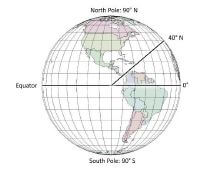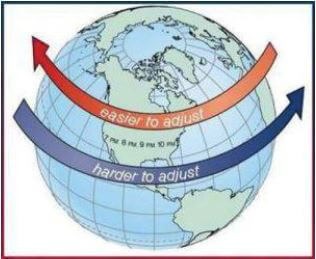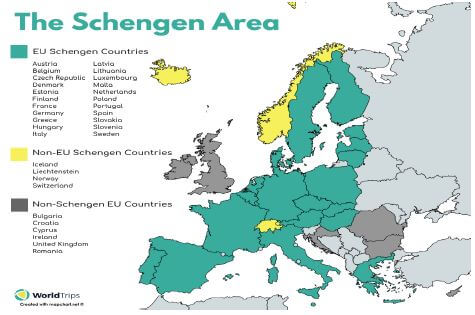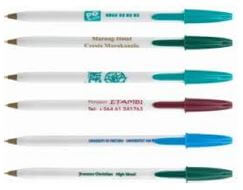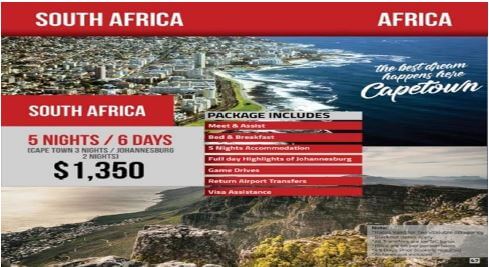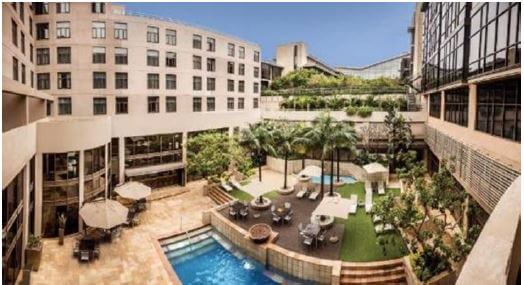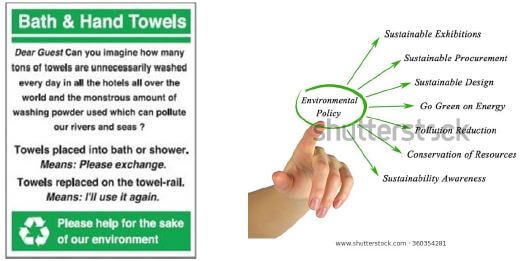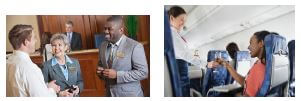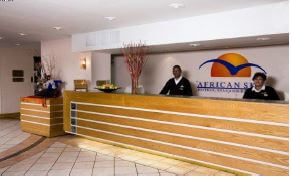Support Document Grade 12 - Tourism Grade 12 Study Guide
Share via Whatsapp Join our WhatsApp Group Join our Telegram GroupNCS (CAPS) LEARNER
SUPPORT DOCUMENT
GRADE 12
TOURISM
STEP AHEAD PROGRAMME
2021
Guide
- Preface
- Time Zones
- Jetlag
- Understanding and Interpreting the Time Zone map
- Steps Used to Calculate Time Across time zones
- Learner Activities: Time Zones
- Map work and tour planning
- Topic: Tourism Sectors
- Topic: Tourism Attrcations
- Tour Planning
PREFACE
This support document serves to assist learners on how to deal with curriculum gaps and learning losses as a result of the impact of COVID-19 in 2020. It also captures the challenging topics in the Grade 11 and 12 work. The lesson plans should be used in conjunction with the 2021 Recovery Annual Teaching Plan. Activities should serve as a guide on how to assess topics dealt with in this document. It will cover the following:
| A | ||
| B | ||
| C | ||
| D | ||
| E | ||
| F |
Time Zones
The section on Time Zones is covered under the Map work and Tour Planning Section. The topic is made up of two parts:
- The theory behind Time Zones including concepts and related aspects to the way in which time is calculated across the world
- The actual calculation of time across the globe as is used by people who travel one place to another.
There are certain aspects of this section that you need to master in order to answer the questions asked in exam papers.
This section will be tested in all tests and exams in your Grade 12 year as it is taught in Term 1. It makes up Section B (Question 2) of your exam papers.
Many learners believe that this section is difficult because there are calculations involved. There are in fact a few steps that you will need to master in order to get all your calculations correct. We will come to that in a little while.
The following is a checklist of what you should know in this section:
- Understand how to use the 24-hour clock when completing time zone calculations
- Understand the given terms and how they impact on world time zones
- Be able to read, interpret and use the Time Zone Map to complete your calculations.
- Use the concepts of longitude and latitude to locate destinations on the Time Zone Map
- Understand the practice of Daylight Savings Time and how it impacts on travel
- Understand how travelling across time zones lead to Jetlag and Jet Fatigue (including the symptoms, causes and prevention).
The 24-hour clock. In tourism we use the 24-hour clock which goes from 24:00/00:00 to 23:59. We don’t use the ‘am” and “pm” method of telling time.
 The earth has imaginary lines that run from East to West and North to South. These lines are called latitudes and longitudes.
The earth has imaginary lines that run from East to West and North to South. These lines are called latitudes and longitudes.
| LATITUDES | LONGITUDES |
|
|
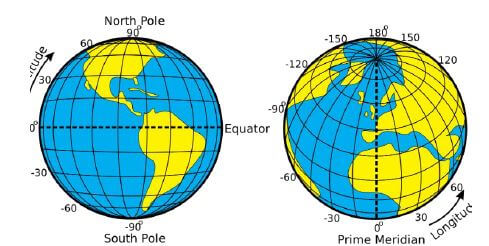
The space between two longitudes is called a TIME ZONE.
- Each time zone is 15º(degrees) apart.
- There is a 1-hour time difference between each time zone.
The earth is round and therefore measures 360º. There are 24 hours in a day.
The movement around the earth around the Sun, in 24 hours is called Rotation. The earth rotates from WEST to EAST.
360º ÷ 24 = 15 = the earth moves 15º every 1 hour.
The Greenwich Meridian was first identified to be used as the meridian from which time is calculated. The time at this meridian was called the Greenwich Mean Time.
The Universal Time Coordinate (UTC) lies on the Greenwich Meridian. All clocks take its time from the UTC, i.e. it standardises how time is kept.
The movement of the earth on its axis over the year (365days) is called Revolution.
The revolution of the earth results in the different Seasons of the year.

The local time is the exact time according to the position of the sun. Places close to each other may experience different times due to the shape of the earth and the effect this has on rotation. It was therefore decided by scientists to use the concept of standard time.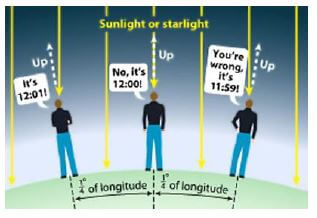
Standard Time is measured from the Greenwich Meridian using the GMT as a guide. Smaller countries where there is only one meridian running through it, takes its time from the same meridian. This is called standard time.
The earth rotates from West to East. Therefore:
All places to the East of the GM are ahead in time
All places to the West of the GM are behind in time.
The (+) and the (-) indicates direction.
If we are at the GM and we want to know the time East of us, we are going to go forward in time, i.e. earlier in time and therefore we will look at the (+). The opposite is true if we want to know the time West of us, then we use the (-)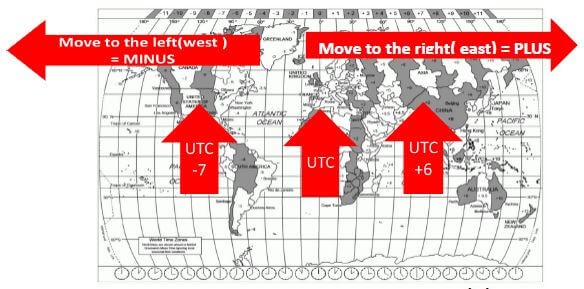
The International Date Line (180º) meridian is 12 hours across the Greenwich meridian (GM).
- When crossing over the IDL, there is a change in the calendar day.
- When one travels West over the IDL (E.g. Japan to Canada), the date will change from today to yesterday.
- When one travels East over the IDL (E.g. Canada to Japan), the date will change from today to tomorrow.
EXAMPLE
Some countries are very wide across their longitudes and therefore all the places in that country cannot take their time from the same time zone, E.g. Australia.
Daylight Saving Time(DST) also referred to as Summer time is a system used by some countries which lie further away from the equator. These countries generally have the sun rising earlier in the mornings and setting earlier in the evening. The sun rises much earlier than for example the norm of 06:00.
These countries therefore feel that they are wasting a lot of valuable daylight when businesses could be operating. They have decided to adapt to the way in which the rotation of the earth takes place.
Daylight Saving Time is where the country decides to set the clocks 1 hour ahead of standard world time in summer. This allows for one hour of daylight to move from morning to evening. The change forward is known as Spring forward. The country will turn their clocks back to standard time once summer is over. This change back is referred to as Fall back.
There have been many reasons for country’s adopting DST. Some of these reasons include:
- Cool hours in the morning could be used more productively rather than the warmer hours later on in the afternoon. This will increase productivity and hence lead to the growth of the economy.
- This practice is actually a green practice because it encourages energy saving because less lights and air conditioners are used.
- It can lead to a reduction in crime as more people return home well before dark.
- There will be reduced road deaths as the evening rush hour would now have more daylight.
- There will be more time for recreation, leisure, family time for both parents and children.
- Recreational areas and tourism establishments make money as they can open for longer hours.
Time zones and Daylight savings time will have an impact on tourists travelling outside of their country, especially across different time zones and hemispheres.
Tourists need to know how the times will change as they move across the globe, i.e. if they move East they are going ahead in time and if they move West they are going behind in time.
If their host country is practicing Daylight Savings Time, they will need to change their watches according and this will also impact on how they plan their itineraries. The times to visit attractions or participate in activities will be impacted by the time being used by the host country.
Changes in time either due to the impact of time zones or DST will also impact on other travel arrangements including flight times and changes, boarding times for trains and cruises, checking into to accommodation, etc. Tourists will also have to be informed about the business hours for establishments such as banks, foreign exchange bureaux’s, etc.
There is also an impact on how the tourist feels when they are travelling. The tourist physical and mental health can be affected by two aspects, namely:
Jetlag which is a tiredness that one feels when travelling across time zones
Jet Fatigue which is a tiredness that one feels from being confined to a space for a prolonged period of time. The cause of jet fatigue is not restricted to the crossing of time zones. A person can feel this even if they have not crossed over time zones.
JETLAG
| SYMPTOMS OF JETLAG | MINIMISING THE IMPACT OF JETLAG |
|
|
Understanding and Interpreting the Time Zone map
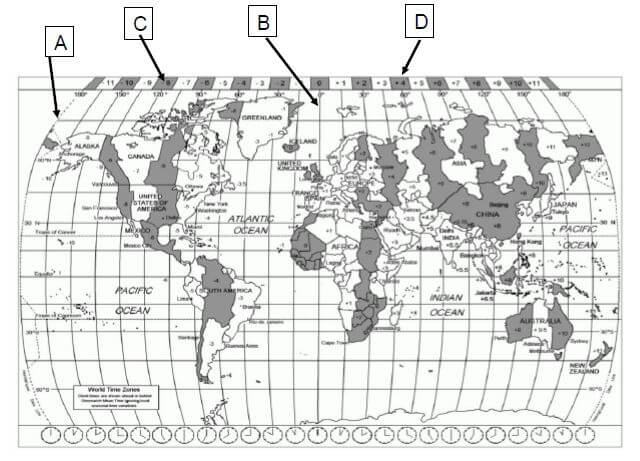
| A | The International Date Line is located at 180° |
| B | The Greenwich Meridian/Prime Meridian is located at 0°. This is the point from which we calculate time. |
| C | (-8) is the 120°W Line of Longitude. It means that all places who take their time using the 120°E meridian are 8 hours behind in time compared to the GM |
| D | (+4) is the 60° Line of longitude. It simply means that places who take their time from the 60°Emeridian are 4 hours ahead in time from the GM. |
| Grey shaded areas mean that all the places with grey will take their time from the same meridian, corresponding to the longitude coloured in grey. E.g. all the places in the Eastern hemisphere shaded in grey and marked +8, take their time from the 120°E meridian. | |
Steps Used to Calculate Time Across time zones
Step 1: Write down all the given information.
- Identify time zones of countries in question.
- In problems where flying time is needed, note the departure time and point as well as the flying time.
Step 2 : Find out if the places are in the same or in different hemispheres.
- If they are in the same hemisphere SUBTRACT, if they are in different hemispheres, ADD
- Same Signs Subtract (SSS) and Different Signs ADD(DSA) to find the time difference in time.
Step 3: Is a country with a question mark AHEAD or BEHIND
- If a country with a question mark is AHEAD you ADD difference.
- If a country with a question mark is BEHIND you SUBTRACT the difference.
- Always start with the place in question, in your statement.
Step 4: When dealing with flight time:
- You Always ADD the flight time when calculating the ARRIVAL.
- You Always SUBTRACT the flight time when calculating the DEPARTURE.
Step 5: When dealing with DST:
- When calculating the ARRIVAL TIME you ADD 1hr of DST if the country in question is practising DST at that time.
- When calculating the ARRIVAL TIME you SUBTRACT 1hr of DST if the country with time (departure country) is practising DST at that time.
- When calculating the DEPARTURE TIME you SUBTRACT 1hr of DST if the country in question is practising DST at that time.
- When calculating the DEPARTURE TIME you ADD 1hr of DST if the country with time is practising DST at that time.
NOTE:
- Some problems include transit time between destinations
- Past papers have also asked for learner to calculate the departure time rather than the arrival time.
YOU MUST GO THROUGH AS MANY PAST PAPERS AS YOU CAN, IN ORDER TO BECOME FAMILIAR WITH THE DIFFERENT TYPES OF PROBLEMS IN TIME ZONE CALCULATIONS.
Examples Using the Steps
Sandile is travelling from Johannesburg to New York. His flight will leave O.R. Tambo at 17:00 on the 12 June. His elapsed time from O.R. Tambo to John F Kennedy International is 16hrs 30mins. Give his arrival time in New York
Step 1: Write down all the given information
- Johannesburg (30ºE) +2 New York (75ºW) -5
17:00, 12 June ?
Flying time = 16hrs30mins
Step 2: Are both places in the same or different hemispheres
- Johannesburg = 30°E => Eastern hemisphere
New York = 75°W => Western Hemisphere
Rule: Both places are in different hemispheres, therefore you will ADD (2+5 = 7HRS) There are 7 hours between both places.
Step 3: Is the place in question East or West of the known place?
- New York (place in question) is West of Johannesburg, therefore you will SUBTRACT
Step 4: Calculate time difference
- 17:00 – 7hrs = 10:00 -> When it is 17:00 in Johannesburg it is 10:00 in New York
Step 5: Add flight time
- 10:00 + 16hrs 30 mins = 02:30 13 June: arrival time
You need to master this kind of problem before your teacher shows you other kinds of time zone problems. You may use your textbooks to examine other examples related to calcualtions.
Learner Activities: Time Zones
Activity 1 – Spot Test on Concepts
QUESTION 1:
Match the term in Column A with the description in Column B. Write only the letter of the correct term.
| Column A | Column B |
| 1.1. IDL | A. Artificial divisions of the world’s surface |
| 1.2. GMT | B. An artificial time boundary corresponding to 180⁰ from the Greenwich Meridian |
| 1.3. Greenwich Meridian | C. The time used in a country, calculated from the meridian that they take their time from. |
| 1.4. Standard Time | D. A temporary change in a country’s standard time during the summer months. |
| 1.5. DST | E. The point of the globe representing the 0⁰ longitude. |
| 1.6. Time Zones | F. Local time at the Greenwich Meridian. |
QUESTION 2: Correct the following statement by replacing the incorrect term/concept
2.1. GMT is the temporary change in a country’s standard time.
2.2. Latitudes divide the Earth into the Eastern and Western hemisphere. 2.3. South Africa has two standard time zones.
2.4. IDL stands for International Data Link.
2.5. The world is divided into 12 time zones
2.6. The International Date Line is also known as Greenwich Meridian.
Activity 2
Read the following article before answering the questions that follow
Daylight Savings Time
Daylight Saving Time (or Summertime as it is called in many countries) is a way of getting more light out of the day by advancing clocks one hour during the summer. During Daylight Saving Time, the sun appears to rise one hour later in the morning,
when people are usually asleep anyway, and sets one hour later in the evening, seeming to stretch the day longer. The reason DST works is because its saves energy due to less artificial light needed during the evening hours - clocks are set one hour ahead during the Spring, and one hour back to standard time in the Autumn. Many countries observe DST, but many do not.
Benjamin Franklin first suggested Daylight Saving Time in 1784, but it was not until World War I, in 1916, that it was adopted by several counties in Europe that had initially rejected the idea.
Note: Between March-April through September-November, it is summer in the northern hemisphere, where many countries may observe DST, while in the southern hemisphere it is winter. During the rest of the year the opposite is true; it is winter in the northern hemisphere and summer in the southern.
Adapted:(https://ticktocktony.com/Newsletter/daylight-savings.html
- What is the abbreviation for Daylight Savings Time?
- Explain why Canada adopts this practice in March.
- Briefly describe the process of Daylight Savings Time.
- “that it was adopted by several counties in Europe that had initially rejected the idea.” Determine TWO reasons why many European countries may have decided to adopt Daylight Savings Time.
- There are arguments on the idea that daylight saving time reduces electricity usage and promotes energy efficiency.
Why is the above statement not completely true? Justify your answer with a good reason. - Identify reasons why there are many countries who choose not to use Daylight Savings Time.
Activity 3 – Jetlag
Study the picture below and then answer the questions that follow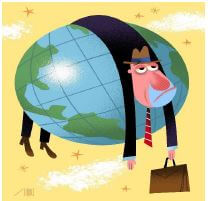
- Explain the difference between jet lag and jet fatigue.
- Refer to the picture and identify symptoms of jet lag that this tourist could be feeling.
- Refer to the diagram below and then answer the question that follows.

Why would a person travelling from West to East suffer greater symptoms of jetlag compared to a person travelling from East to West?
Activity 4
Using the World Time Zone Map, answer the following questions.
- Give the location (longitude and continent) where one will find the following countries:
- San Francisco
- Lagos
- Johannesburgh
- Adelaide
- India is +5,5 on the Time Zone Map. What does this mean?
- For each of the following time zones, give the time difference with the UTC:
- 75ºW
- 30º E
- 120ºE
- 15ºW
- Complete the following table, if the time at the UTC is 12:00
COUNTRY DIFFERENCE IN º DIFFERENCE IN TIME AHEAD/BEHIND OF THE UTC TIME Rio de Janeiro Berlin Perth Tehran Between 45ºE and 60ºE = 3,5hrs 3,5hrs Ahead 15:30
Activity 5
Using your Time Zone Map, complete the following calculations. Show all workings.
- Zandile is working late in her Johannesburg (30ºE) office. She needs to make a phone call to her colleague Jane in Canada (105ºW). She will make the call at 16:00 SAST. Is this call possible?
- A businessman flies from Hong Kong (120ºE) to Johannesburg. He leaves Hong Kong at 12:30 on Sunday. What time and day will he arrive in Johannesburg, if he takes a 13-hour flight.
- Skhumbuzo will be departing from OR Tambo International Airport (30ºE) for Auckland (180ºE). He will leave at 18:00, Tuesday. His flight time is 18hrs. Auckland is practicing Daylight Savings Time.
- Peter leaves Paris (15ºE) on Friday at 08:00. He travels to New York (75ºW) on a 9-hour flight. What is his arrival time in New York?
- Keshnee who is studying in Lima, Peru (75ºW) makes a phone call to her parents who are living in Riyadh (45ºE). If she makes the call at 06:00, at what time will they receive the call? Lima is practicing DST.
- A group of educational tourists travel from Sao Paulo(45ºW) to Namibia (15ºE). They leave Sao Paulo at 05:00 on Wednesday and take a 6 hour flight to New York. The will remain in transit in New York for 4 hrs before flying to Namibia. The flight from New York to Namibia is 16 hours.
- Ayanda flew from San Francisco (120ºW) to Dallas (90ºW). She arrived in Dallas at 08:00 on Wednesday. Calculate her departure time from San Francisco if the flight was 3 hours long.
MAP WORK AND TOUR PLANNING
TRAVEL DOCUMENTS
- Passport
- PASSPORT - A document issued by a national government that certifies the identity (name, date of birth, gender and place of birth) and nationality of its holder.
- The passport is issued by the Department of Home Affairs
- Valid for 10 years’ adult
- Requirements: A completed Application from
- Proof of identity
- Two size electronic photographs will be taken inside the DHA
- Required fee
- Different types of Passports
Types of Passports Description Valid for 1 Passport These passports are issued to citizens who are 16 years of age or older, and are intended for occasional travel, such as vacations and business trips 10 years. 2 Maxi passport Similar to regular passports, but they contain 48 pages to cater for frequent travellers. Like regular passports, they are issued to citizens aged 16 and older 10 years and are non-renewable.
New passport applications have to be filed.3 Child passport These passports are issued to citizens who are 15 years of age or younger. 5 years, and are non-renewable 4 Official passport These passports are issued to officials attached to government institutions who have to travel on official business. They are valid for five years. 5 Diplomatic passport Issued to diplomats and representatives for work related travel, and to their accompanying dependents.
- PASSPORT - A document issued by a national government that certifies the identity (name, date of birth, gender and place of birth) and nationality of its holder.
- Visa
A visa is an endorsement on a passport giving the holder permission to travel to, enter, transit or remain in a foreign country.
The visa is issued by Consulate or Embassy- Requirements:
- Valid passport
- Specific visa fee
- Return air ticket
- Two passport sized photographs
- Proof of sufficient financial means
- Types of Visas – Uni-visa, Multi-visa / Schengen visa
Example: Schengen Visa countries
Advantages of using Schengen visa / multi-visa- Saves money because you only pay for one visa.
- Saves time because you don’t visit different embassies to apply for the different visas.
- Requirements:
- Health Certificate / Yellow Fever certificate
A health certificate is a statement signed by a health-care provider (such as a registered travel doctor) that proves the health of the bearer of the certificate. Health certificate can be obtained from TRAVEL CLINICS - International drivers permit
Permits a tourist to drive in a foreign country
IDP can be obtained from AA (Automobile Association)- Requirement needed
Requirement needed to obtain International Driver’s Permit:- Valid driver’s Licence,
- 2 photographs, Fees,
- Identity document,
- Application form,
- Proof of residence.
- Functions of IDP
- Helps the tourist to rent a vehicle in another country and obtain travel insurance.
- Requirement needed
ACTIVITIES
Four options are provided as possible answers to the following questions. Choose the answer and write ONLY the letter (A–D) e.g. 1.1.21 A.
1.1.1This type of visa applied for when travelling to European Union Countries.
- Brazilian
- Scottish
- Schengen
- American
1.1.2. An IDP is required to …
- participate in local cultural activities.
- fly an light aircraft in a foreign country.
- hire a vehicle at certain foreign destinations
- participate in white water rafting activities.
1.1.3 A South African applying for this travel document needs to submit a South African identity document, a completed application form and pay a fee.
- Passport
- Health certificate
- International driving permit
- Visa
1.1.4 A South African outbound international tourist who wants to visit China will apply at the … for a holiday visa.
- Department of Home Affairs
- National Department of Tourism
- Asian Embassy
- Chinese Embassy
1.1.5 A South African outbound international tourist would apply to the …for a transit visa when changing flights at Heathrow International Airport in London.
- Department of Economic Affairs
- British Embassy
- Department of Home Affairs
- American Embassy
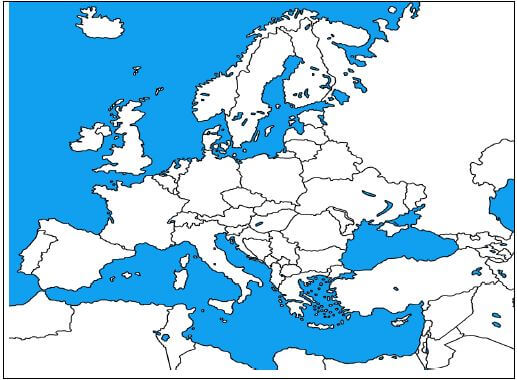
1.1 Name the 22 Schengen member countries and colour each country using their flag colours.
1.2 Eric wants to take a gap year, touring France, Italy and Germany. List FOUR travel documents that Eric would need for his trip.
2.1 Choose a service from COLUMN B that matches the service provider in COLUMN A. Write only the letter (A–F) next to the question number
| COLUMN A | COLUMN B | |
| 1 | Travel clinic | a. international driver's permit |
| 2 | Department of Home Affairs | b. visa document |
| 3 | AA (Automobile Association) | c. yellow fever certificate |
| 4 | Embassy | d. passport |
Study the information below and answer the questions that follow.
 | A Schengen Visa gives a tourist entry into 22 countries who are members of the European Union. John has to go to the Switzerland Embassy to apply for a Schengen Visa. |
3.1 Differentiate between a passport and a visa. (2 × 2) (4)
3.2 Give ONE reason why John would require a Schengen Visa for the race. (2)
USA Visa Requirements:
| JOHN |
3.3 Name the place where John will hand in an application to obtain a passport (1)
3.4. Suggest ONE reason why visa applicants are required to provide the US Embassy or Consulate with supporting documents in order to obtain a visa. (2)
Topic: Tourism Sectors
Content: Professional image in the tourism industry
Professional image in the tourism industry
- When working in the tourism industry it is important that professional image is portrayed at all times.
- Company and staff image are important when dealing with tourists from different countries and backgrounds.
- They contribute to the professional image in the tourism industry.
Factors contribute to a professional image in the tourism industry.
Examples of aspects to consider include:
COMPANY IMAGE: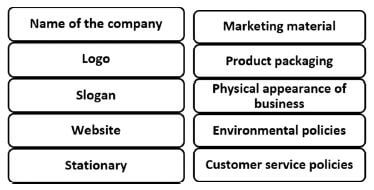
Name of company
People get to know a company’s name and they learn to trust it tOR associate it with poor service.
Logo
- A company’s identity is expressed by its logo and the colour thereof. The logo (or symbol or trademark) is the recognisable feature of the brand or company.
- The logo is used on most visible features of the company, such as uniforms, stationery, marketing material and signage.
- All of this together is called a company’s branding and is what establishes its corporate identity.
Slogan
- A slogan is a short phrase that communicates a brand’s core values.
- Slogans should be printed on all the company’s promotional items, including its website, stationery, marketing material and merchandise.
- A slogan must be memorable and reflect the company philosophy.

Website
- The website must be up to date, user-friendly and well designed.

Stationary
- Stationery refers to office supplies such as letterheads, envelopes, registration forms, invoices, notepads, business cards.


Marketing
- Marketing material is all printed material with information about a company’s products, such as flyers, brochures, maps, business cards, leaflets, fact sheets, postcards, and posters as well as videos.
- Marketing material also includes online marketing through websites, newsletters, and social media.

Product packaging
- Product packaging refers to the way in which product features and benefits are combined to appeal to consumers.
- Example: A package holiday is made up of elements such as flights, coach transfers, accommodation, excursions, and the attractions that have been selected by the tour operator. It is important that all components reflect the tour operator’s image

Physical appearance of the business
- The physical appearance – exterior and interior elements of a company – also portrays an image.
- Exterior elements include signage, the parking area and landscaping, and interior elements include the design, layout and equipment.
- For example, windows must be clean, signage must be visible, and the décor must reflect the image of the company.

Environmental policies
- An environmental policy is a written statement that outlines a company’s aims and principles with regards to managing (limiting) the effect it has on the environment.
- Consumers are increasingly choosing to do business with companies that are committed to protecting the environment.
- A commitment to responsible tourism and conserving the environment projects a positive and responsible image.

Customer service policies
- Contains a statement to the customer about the levels of service they can expect
- Standards that can be expected.

Factors contributing to a professional image in the tourism industry.
IMAGE OF THE STAFF
What is a staff image?
- Staff image refers to the presentability of employees when dealing with tourists and when carrying out their duties.
Aspects to consider to create professional image.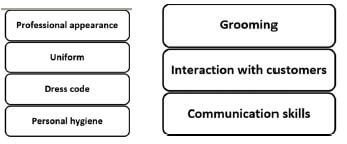
Professional appearance
- A professional appearance is key to making a good impression and creating a professional image of yourself and your company
Uniforms
- Staff uniforms must be appropriate to the image and type of company.

Dress Code
- If employees are not required to wear a uniform, they will still have to adhere to a dress code that specifies what they may or may not wear.
- Having a dress code ensures that staff still looks neat, tidy and professional even though they aren’t in uniform.

Personal hygiene
- Staff should be free of body odour and avoid strong fragrance.
- Nails and hair must be clean and neat.

Personal grooming
- Staff should be neatly groomed.
- Women should wear little make- up.
- Jewellery should be limited and must be appropriate.

Interaction with customers
- Staff must be always polite and courteous to guests.
- Excellent service can enhance a company’s image; poor service will damage a company’s image and business.
- Avoid bad habits, such as smoking in front of customers.

Communication Skills
- Whenever staff deals with customers, they are communicating, whether it is face to face, over the telephone, in writing or non-verbally (through body language).
- The way in which an employee speaks, presents information in person or in writing and/or their body language determines the impression that employee makes personally and of the company.
- Communicate confidently and honestly.
- Do not use slang or bad language.

Conditions of Employment
The Basic Conditions of Employment Act 75 of 1997
- It refers to the terms under which employer has employed a person.
- The Department of Labour is the South African Government responsible for matters related to employment.
- The Act applies to all employees and employers.
- The Act protects employees and employers by outlining the minimum basic working conditions.
- The Act gives effect to the right to fair labour practices.
- The basic conditions of employment contained in the Act form part of the employment contract between the employer and employee.
The Contract of Employment
- A contract of employment is a signed agreement between an employer and an employee.
- Signing a job contract signifies an agreement between the employer and employee.
- The contract of employment has rules that the employee should abide by when working for the company that has issued it.
Information Contained in The Contract of Employment.
Employer and employee details
- Employer’s full name and address
- Employee’s full name and address
Employment details
- Place of work
- Date on which employment starts
- Job title
- A brief description of the job including core duties
- Working hours
Remuneration and deductions
- Agreed minimum salary or wage
- Rate for overtime
- Frequency of payment (daily, weekly, monthly)
- Any deductions (UIF, medical aid, pension fund, trade union membership fees, home loan and tax e.g. PAYE)
Notice and contract period
- Period of contract
- otice period required from the employee as well as the employer, should either wish to terminate the contract
Leave details
- Any leave to which the worker is entitled
- This includes, but it is not limited to sick leave, annual leave, study leave, maternity leave, family responsibility leave
Uniform allowances
- Depending on the company policy, the employer could provide one uniform, more than one uniform, seasonal uniforms or the policy may stipulate that employees are entitled to a uniform allowance
Travel benefits
- This is a decision of the employer
- Some airlines provide discounted flight travel benefits to employees
- Some hotels may agree to a travel allowance for employees
- National Parks grant travel benefits to employees for the performance of official duties
Fringe benefits
- Fringe benefits are benefits in addition to an employee's wages.
- Any benefit offered to employees in exchange for their services (not including salary) is a fringe benefit
- Examples include: pension fund, medical scheme, unemployment insurance, disability insurance, vehicle allowance, study loans and bursaries
Professional accountability and responsibility
- The obligation/requirement to fulfil duties and accept responsibility for the consequences of actions and decisions, be they positive or negative.
Service ethics
- The moral principles that govern a company's conduct with its customers, potential customers and ex customers.
- They are based on a set of values relating to the question of what is “right” or “wrong.”
Disciplinary and grievance procedures
- A disciplinary procedure is used by an employer to address an employee's conduct or performance
- The aim of a disciplinary procedure is to encourage and maintain standards of conduct and ensure consistent and fair treatment for all e.g. verbal warning, written warning, firing an employee
- A grievance procedure is used to deal with a problem or complaint that an employee raises.
Signatures
- Signature of the employer
- Signature of the employee.
Purpose and value of a code of conduct
Code of conduct
- A code of conduct is a set of rules that provides guidance to all staff on what is acceptable behaviour.
- It contains procedures to follow in certain situations and requires certain behaviour.
The purpose of a code of conduct
- It spells out the expected conduct of staff in their performance of duties.
- Offers guidance for staff with ethical challenges.
- Guides behaviour.
- Acts as a public statement providing the customers of a business with an understanding of the ethics of the company.
The value of a code of conduct
- Creates a cooperative, collaborative atmosphere.
- Promotes integrity in the workplace.
- Creates agreed upon behaviours and methods of operation for the business.
- Leads to improved company performance if linked to the aims and objectives of the company.
- States the company’s unique set of values and beliefs.
- Can be used to create publicity and attract new customers, thus helping the organisation to grow.
TOURISM SECTORS: LEARNER ACTIVITIES
Study the information below and answer the questions that follow.
- Refer to the above extract and explain how this company succeeded in establishing a positive brand image through the following:
- It’s logo (2)
- The name of the business (2)
- The physical appearance of the business (2)
- The special attraction for parents with young children (2)
- State TWO advantages of the Steak Beef Ranches having a recognizable, positive image. (4)
- Refer to the photographs above and discuss TWO points that can form part of the dress code for waiters working at a Steak Beef Ranches restaurant. (4)[16]
Study the web designs underneath and rates them according to the criteria provided and the information in the extract:
WEB 1
WEB 2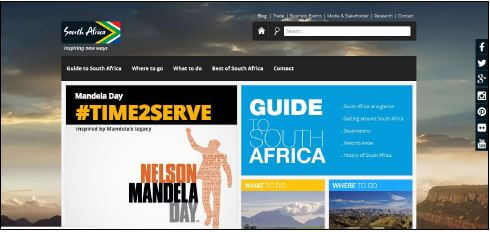
| CRITERIA | WEB 1 | WEB 2 |
| Image | ✓✓ | ✓✓ |
| Target audience | ✓✓ | ✓✓ |
| Usability | ✓✓ | ✓✓ |
| Layout | ✓✓ | ✓✓ |
| Content | ✓✓ | ✓✓ |
| Media | ✓✓ | ✓✓ |
[28]
Identify the problem in the cartoon taken from Cartoon Stock below and provide a possible solution, explaining two reasons for your answer. Your answer must be in a paragraph format. 
(5)
4.1. Study the picture below and answer the question that follows.
AFRICAN SKY HOTEL SPAS AND RESORTS African Sky Hotel Spas and Resorts is the great company to work for. They really look after the wellbeing of their employees. If you are in the lower to upper management you can enjoy the benefits of the use of the various properties and their facilities. There is a lot of passion within the company and hard workers are recognised through company incentives for example the company give workers fully paid holidays and they held year end functions where they award hard working employees. Great value system in place with the correct people. The company want to move forward and stay in line with technology and ever changing markets. |
4.1.1. Professional image is very important in ensuring the success of a business. What do you understand by the term professional image? (2)
4.1.2. In the extract, discuss two ways in which the African Sky Hotel Spas and Resorts motivate its employees. (4)
4.1.3. The employees play a huge role in attracting customers to their business. Suggest two ways in which employees can maintain the professional image of a business. (5)
4.1.4. Define the following conditions that are included in a contract of employment.
- Fringe benefits (2)
- Remuneration (2) [15]
5.1. Study the extract below and answer the questions that follow. 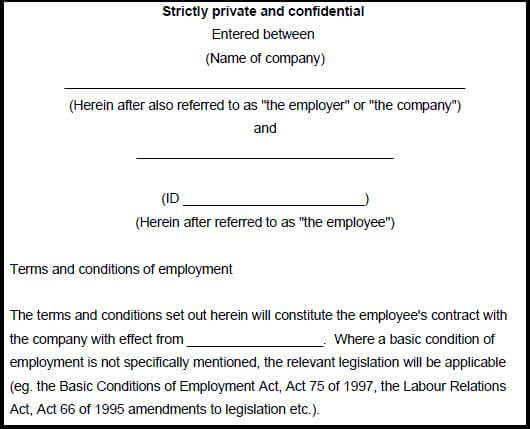
5.1.1. Identify the document from which this extract has been taken. (2)
5.1.2. ‘Many of the conditions of employment, such as leave and working hours, are governed by government legislation.’ Name the government legislation that is being referred to in this statement. (2)
5.1.3. The document mentioned in 5.1.1 is a vital agreement in the workplace. Explain why would you consider this document an essential in the workplace? (4)
5.2. Study the pictures of employees at the I CARE CAR RENTAL below and answer the questions that follow. 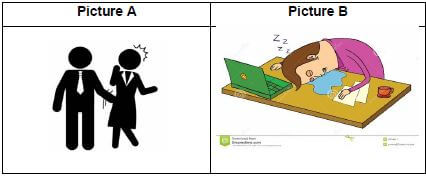
5.2.1. Identify the inappropriate behaviour shown in picture A and picture B. (2)
5.2.2. Discuss TWO ways in which the inappropriate behaviour of the staff members in the pictures above can impact negatively on the profitability of the I CARE CAR RENTAL Company. (2)
5.2.3.
- State the document that the company should have in place in order to prevent what is happening in the pictures shown above. (1)
- Explain the purpose of the document mentioned above. (2) [15]
Topic: Tourist attractions
Content: Famous world icons and attractions
| The difference between a tourist attraction and an icon | A tourist attraction is a place, an area, a building or an event of interest that tourists visit for its historical significance, cultural value, natural or human-made beauty or entertainment opportunities e.g. natural attractions (waterfalls, mountains, forests and wildlife) and human-made attractions (theme parks, festivals, historical buildings and statues). An icon in the tourism context is an attraction or feature that is world famous, has symbolic value and is closely associated with a particular destination. |
| Reasons why specific tourism attractions and/or physical features are regarded as icons |
|
| The economic significance of icons for a country/area | Some of the factors that contribute to the economic significance of icons are that they:
|
ICONS & ATTRACTIONS
| NAME OF ICON | Sydney Opera House | |
| COUNTRY | Australia | |
| CITY/ TOWN | City: Sydney | |
| WHY IT IS AN ICON? | It is universally recognised as an architectural masterpiece of the 20th century because of its design and construction. | |
| DESCRIPTION | It is located in Sydney Harbour, close to the Sydney Harbour Bridge. It’s creative roof design of interlocking “shells” are shaped like sails of a sailboat It is one of the most famous performing arts centres in the world The building houses five theatres, a recording studio, cafés, restaurants, bars and souvenir shops. | |
| NAME OF ICON | Ayers Rock / Uluru-Kata Tjuta National Park* | |
| COUNTRY | Australia | |
| CITY/ TOWN | State: Northern Territory | |
| WHY IT IS AN ICON? | Uluru or Ayers Rock is a unique, massive, round rock formation composed of hard, red sandstone. | |
| DESCRIPTION | Ayers Rock or Uluru lies in the Uluru-Kata Tjuta National Park in the Northern Territory of Australia. The park is named after Uluru, a single rock dome and Kata Tjuta, a range of rock domes. Formed through erosion over 500 million years, it is the most spectacular natural landmark in Australia. | |
| NAME OF ICON | The statue of Christ the Redeemer | |
| COUNTRY | Brazil | |
| CITY/ TOWN | City: Rio de Janeiro | |
| WHY IT IS AN ICON? | With its outstretched arms overlooking the city of Rio de Janeiro it is one of the most famous statues in the world and is known not only for its dramatic location and size, but also as a symbol of Christianity and peace. | |
| DESCRIPTION | The statue of Christ the Redeemer is situated on top of Corcovado Mountain At a height of 700 m it overlooks the city of Rio de Janeiro. It was built to commemorate the 100th anniversary of Brazil’s independence from Portugal in 1922 It offers spectacular views of the city, Sugar Loaf Mountain, the Maracana Soccer Stadium and the famous beaches of Copacabana and Ipanema | |
| NAME OF ICON | Niagra Falls | |
| COUNTRY | Canada and USA | |
| CITY/ TOWN | Niagara Falls, Ontanario (Canada)and Niagara Falls, New York (USA | |
| WHY IT IS AN ICON? | The Niagara Falls is the most famous waterfall in the world. It is one of the biggest and most powerful and receives more visitors than any other waterfall. | |
| DESCRIPTION | Niagara Falls on the Niagara River is located on the international border between the province of Ontario, Canada and the State of New York. | |
| NAME OF ICON | Colosseum | |
| COUNTRY | Italy | |
| CITY/ TOWN | City of Rome | |
| WHY IT IS AN ICON? | It is the largest amphitheatre constructed during the Roman Empire and is regarded as the greatest example of Roman engineering and architecture. It is nearly 2 000 years old. | |
| DESCRIPTION | It was originally known as the Flavian Amphitheatre. The Colosseum, which could seat over 50 000 people, was built to provide a place of entertainment for Roman citizens. | |
| NAME OF ICON | Learning Tower of Pisa | |
| COUNTRY | Italy | |
| CITY/ TOWN | City of Pisa | |
| WHY IT IS AN ICON? | Because of its beauty and the fact that it has tilted. It is the most recognisable structure in the world. | |
| DESCRIPTION | The Tower or campanile is one of three historic buildings located on the Piazza del Duomo (Cathedral Square). | |
| NAME OF ICON | Venice | |
| COUNTRY | Italy | |
| CITY/ TOWN | City Of Venice | |
| WHY IT IS AN ICON? | It was built on 118 small islands linked by canals and bridges, it is one of the most beautiful cities in the world and its famous for its architecture and art. | |
| DESCRIPTION | It is located in the lagoon on the shore of the northern Adriatic sea. | |
| NAME OF ICON | Vatican City | |
| COUNTRY | Italy | |
| CITY/ TOWN | Rome | |
| WHY IT IS AN ICON? | Vatican City also known as the Vatican, is the world smallest independent city state, the city of the Roman Catholic church and its ruled by its head, the Pope. | |
| DESCRIPTION | It was established in 1929 and is completely surrounded by the City of Rome. | |
| NAME OF ICON | The Great Pyramids of Giza | |
| COUNTRY | Egypt | |
| CITY/ TOWN | City of Giza | |
| WHY IT IS AN ICON? | They were constructed over 4500 years ago as massive tombs for the Egyptian pharaohs | |
| DESCRIPTION | There are nearly 1000 pyramids in Egypt. The three most famous pyramids are located near the Nile River. | |
| NAME OF ICON | The Sphinx | |
| COUNTRY | Egypt | |
| CITY/ TOWN | City of Giza | |
| WHY IT IS AN ICON? | It is a huge statue with the body of a lion and the head of human. | |
| DESCRIPTION | It is located in front of the Great Pyramid at Giza, 25 km from Cairo. Its exact construction date and purpose is not known. | |
| NAME OF ICON | Berlin Wall | |
| COUNTRY | Germany | |
| CITY/ TOWN | City of Berlin | |
| WHY IT IS AN ICON? | It was built in 1961, separating West Berlin from East Berlin. | |
| DESCRIPTION | In 1945, World War II came to an end with the defeat of Hitler’s Nazi Germany. Germany and the City of Berlin was divided into four allied (USA, Britain, France and the USSR) occupation zones. | |
| NAME OF ICON | Black Forest | |
| COUNTRY | Germany | |
| CITY/ TOWN | State : Baden-Wurttemberg | |
| WHY IT IS AN ICON? | It is known for its beautiful scenery consisting of mountains covered with pine and fir trees. | |
| DESCRIPTION | The region is 200 km long and 60 km wide and lies in the state of Baden-Wurttemberg is Southern Germany | |
| NAME OF ICON | The Dome of the Rock | |
| COUNTRY | Israel | |
| CITY/ TOWN | Jerusalem | |
| WHY IT IS AN ICON? | Is an Islamic shrine built on sacred rock. It is the third most holy site in the world for Muslims. | |
| DESCRIPTION | Is located on the Temple mount, is the oldest Islamic monument in the world. | |
| NAME OF ICON | The Wailing Wall | |
| COUNTRY | Israel | |
| CITY/ TOWN | Jerusalem | |
| WHY IT IS AN ICON? | It is located on the west of the Temple Mount in the old City of Jerusalem. The most holiest Jewish site in the world. | |
| DESCRIPTION | Also known as the Western Wall or Kotel (Hebrew), this 2000 year old wall is all that remains of a retaining wall that surrounded the second Temple built by Herold the Great. | |
| NAME OF ICON | The Great Wall of China | |
| COUNTRY | China | |
| CITY/ TOWN | Beijing | |
| WHY IT IS AN ICON? | It dates back 2000 years and is the world’s longest human made defence structure. | |
| DESCRIPTION | It was built between the 5th century BC and the 16th century AD by several Chinese emperors to protect China against invaders. | |
| NAME OF ICON | The Parthenon | |
| COUNTRY | Greece | |
| CITY/ TOWN | Athens | |
| WHY IT IS AN ICON? | It is the remains of a 2 500 year old temple located on the Acropolis, a hill overlooking the city of Athens. | |
| DESCRIPTION | The temple was built in honour of Greek goddess, Athena, the patron of Athens, for protecting Athens during war. | |
| NAME OF ICON | The Taj Mahal | |
| COUNTRY | India | |
| CITY/ TOWN | Agra | |
| WHY IT IS AN ICON? | The Taj Mahal is constructed of white marble. It was built by an Indian ruler as a symbol of his everlasting love for his deceased wife. | |
| DESCRIPTION | Shah Jahan, the Mughal Emperor of Southern Asia, ordered the construction of the Taj Mahal in 1631 to honour the memory of his favourite wife, Mumtaz Mahal, who died while giving birth to their 14th child. | |
| NAME OF ICON | The Blue Mosque | |
| COUNTRY | Turkey | |
| CITY/ TOWN | Istanbul | |
| WHY IT IS AN ICON? | The Blue Mosque in Istanbul, Turkey, with its cascading domes, decorated with ceramic blue tiles on the inside, its courtyards and six minarets, is considered one of the most beautiful mosques in the world. | |
| DESCRIPTION | The Blue Mosque was built by Sultan Ahmed I between 1609 and 1616. Its official name is the Sultan Ahmet Mosque. The 34 m-high main dome is surrounded by eight smaller cascading domes and semi-domes. | |
| NAME OF ICON | The Eiffel Tower | |
| COUNTRY | France | |
| CITY/ TOWN | Paris | |
| WHY IT IS AN ICON? | The Eiffel Tower is the world’s most famous tower and a symbol of Paris. It is the tallest structure in Paris and the most-visited tourist attraction in the world that charges an admission fee. | |
| DESCRIPTION | The Eiffel Tower is made from iron lattice and is situated on the southern bank of the Seine River in Paris, France. It was built by the French structural engineer Gustave Eiffel as an archway to the International Exhibition of Paris in 1889 and to celebrate the 100th anniversary of the French Revolution | |
| NAME OF ICON | The French Riviera | |
| COUNTRY | France | |
| CITY/ TOWN | Nice | |
| WHY IS IT AN ICON? | The French Riviera or Côte d’Azur is one of the most famous and luxurious coastal resort areas in the world. It lies on the Mediterranean coast of south-eastern France on the border with Italy. | |
| DESCRIPTION | The French Riviera is known for its blue water, scenic beauty, dramatic coastline, warm weather and beaches. | |
| NAME OF ICON | Mount Fuji | |
| COUNTRY | Japan | |
| CITY/ TOWN | Tokyo | |
| WHY IS IT AN ICON? | Mount Fuji is the highest mountain in Japan. This volcanic mountain is world famous for its near perfect symmetrical cone shape and is recognised as a symbol of Japan. | |
| DESCRIPTION | Mount Fuji is surrounded by five beautiful lakes and is in the Fuji-Hakone-Izu National Park approximately 100 km south-west of Tokyo, the Japanese capital. The volcano last erupted in 1707 but although it has been dormant since then, geologists still regard it as active. | |
| NAME OF ICON | Chichen Itza* | |
| COUNTRY | Mexico | |
| CITY/ TOWN | Region: Yucatán Peninsula | |
| WHY IS IT AN ICON? | Chichen Itza is the ruined remains of a large, ancient Mayan city. It is one of the best preserved archaeological sites of the ancient Mayan civilization | |
| DESCRIPTION | Chichen Itza lies on the Yucatán Peninsula in Mexico. With its stone temples, pyramids, astronomy observatory and ball courts Chichen Itza was a powerful Mayan political, spiritual, ceremonial and trading centre between 500 AD and 1100 AD. The city was later abandoned and visited by Mayan pilgrims only until the Spanish arrived in the 16th century. | |
| NAME OF ICON | Petra | |
| COUNTRY | Jordan | |
| CITY/ TOWN | Wadi Musa | |
| WHY IS IT AN ICON? | This desert city, hidden in a narrow valley between mountains, has been carved from solid rock, making it one of the most spectacular ancient cities in the world. Petra, which means “rock” in Greek, was constructed around 100 BC as the capital city of the | |
| DESCRIPTION | Petra is located outside the town of Wadi Musa in southern Jordan. From 600 BC to 106 AD the Nabateans settled in Petra and developed it into a wealthy caravan trading centre that linked the spice and silk routes of China, India and Arabia with Egypt, Syria, Greece and Rome. | |
| NAME OF ICON | Mount Everest | |
| COUNTRY | Nepal | |
| CITY/ TOWN | Kathmandu | |
| WHY IT IS AN ICON? | Mount Everest is the highest mountain in the world. The peak is 8 848 m above sea level. | |
| DESCRIPTION | Mount Everest lies on the border between Nepal and Tibet (China) in South Asia and forms part of the Himalaya mountain range. This 60-million-yearold mountain is always covered with ice and snow. Its peak is shaped like a pyramid. | |
| NAME OF ICON | Mecca | |
| COUNTRY | Saudi Arabia | |
| CITY/ TOWN | Mecca | |
| WHY IT IS AN ICON? | Mecca, the most sacred city of the Islam faith, is the spiritual centre of all Muslims. It is the birthplace of the Prophet Muhammad, the founder of the Islamic faith, and the focal point of Muslim pilgrimage. | |
| DESCRIPTION | The most holy site in Mecca is the Kaaba, located in the courtyard of the Masjid al Haram (Grand Mosque), the holiest mosque in the world. | |
| NAME OF ICON | The Swiss Alps | |
| COUNTRY | Switzerland | |
| CITY/ TOWN | Area: Cantons of Berne and Valais | |
| WHY IT IS AN ICON? | The Swiss Alps Jungfrau-Aletsch is a protected area in south-western Switzerland. This beautiful region has high mountain peaks that are permanently covered in snow, glaciers and valleys. | |
| DESCRIPTION | The Jungrau-Aletsch is located between the cities of Interlaken and Brig in the Swiss cantons of Berne and Valais. There are nine mountains of over 4 000 m high each in the region. Of these, the peaks of Eigar, Monch and Jungfrau are the most spectacular. | |
| NAME OF ICON | Windmills | |
| COUNTRY | The Netherlands | |
| CITY/ TOWN | Area: All over the Netherlands | |
| WHY IT IS AN ICON? | Windmills are one of the main symbols associated with the Netherlands. Not only are they characteristic of the Dutch landscape, they are also a symbol of the Dutch struggle against water. | |
| DESCRIPTION | Windmills in the Netherlands date back to the 14th century and there were over 10 000 in use by the early 20th century. | |
| NAME OF ICON | Machu Picchu | |
| COUNTRY | Peru | |
| CITY/ TOWN | Cuzco | |
| WHY IT IS AN ICON? | Machu Picchu, an ancient Inca city in the Andes Mountain in Peru, is one of the most important and mysterious archaeological sites in the world. | |
| DESCRIPTION | Machu Picchu is located in the Andes Mountains, 80 km from the city of Cuzco in Peru. It lies at 2 430 m above sea level. | |
| NAME OF ICON | Auschwitz | |
| COUNTRY | Poland | |
| CITY/ TOWN | Auschwitz | |
| WHY IT IS AN ICON? | Auschwitz was Nazi Germany’s largest concentration camp, forced labour and extermination camp complex in Europe from 1940 to 1945 | |
| DESCRIPTION | Auschwitz in southern Poland is the town where the Nazis established their largest concentration camps after invading Poland in 1939. | |
| NAME OF ICON | The Algarve | |
| COUNTRY | Portugal | |
| CITY/ TOWN | Faro | |
| WHY IT IS AN ICON? | The Algarve is Portugal’s most popular tourist region and one of Europe’s favourite holiday destinations. This region is renowned for the natural beauty of its dramatic coastline, sunny weather, excellent beaches, opportunities for outdoor activities and great food. | |
| DESCRIPTION | The Algarve lies on the southern tip of Portugal with the Atlantic Ocean as its southern and western border. | |
| NAME OF ICON | Alcazar of Segovia | |
| COUNTRY | Spain | |
| CITY/ TOWN | Segovia | |
| WHY IT IS AN ICON? | The Alcázar of Segovia is the most recognisable fortress castle in Spain. It is built on top of a huge rocky hill and shaped like the bow of a ship. This fortress dates back centuries and is one of the most visited monuments in Spain. | |
| DESCRIPTION | -The Alcázar (castle) lies in the old city of Segovia in the province of Segovia in Spain. Originally built as a wooden fortress by the Arabs during their occupation of Spain, it was recaptured by the Spanish who rebuilt it as a stone structure in the 12th century. | |
| NAME OF ICON | Bull fights | |
| COUNTRY | Spain | |
| CITY/ TOWN | Madrid, Seville and Pamplona | |
| WHY IT IS AN ICON? | The practice of bullfighting, in which a bullfighter in the public display provokes and then kills a bull with a sword, is universally associated with Spain’s history and culture. | |
| DESCRIPTION | Bullfights take place in a large outdoor arena. When the bull (toro) enters the ring the bullfighter (matador), who is carrying a cape and sword, wearing a colourful embroidered silk costume, provokes it. | |
| NAME OF ICON | Floating markets | |
| COUNTRY | Thailand | |
| CITY/ TOWN | Bangkok | |
| WHY IT IS AN ICON? | The colourful and vibrant floating markets where traders sell their goods from their boats on the rivers and canals have become a symbol of the traditional way of life in Thailand | |
| DESCRIPTION | Floating markets (Talaat Naam) are known for the Thai women dressed in blue shirts (Mor Hom) and flat topped hats (Muak Nob) who paddle alongside the canal. | |
| NAME OF ICON | The Kremlin | |
| COUNTRY | Russia | |
| CITY/ TOWN | Moscow | |
| WHY IT IS AN ICON? | The Kremlin is a fortified complex of buildings in the city of Moscow. | |
| DESCRIPTION | The Kremlin lies on a hill in the centre of Moscow, on the Moscow River. It is surrounded by a 2,2 km-long red brick wall and 20 defensive towers forming an irregular triangle. Cathedral Square is at the centre of the Kremlin. | |
| NAME OF ICON | The Red Square | |
| COUNTRY | Russia | |
| CITY/ TOWN | Moscow | |
| WHY IT IS AN ICON? | The Red Square in the centre of Moscow, is a large public square surrounded by significant buildings. It has been the site of many historical events since the 15th century and is considered to be the most famous tourist attraction in Moscow. | |
| DESCRIPTION | The Red Square separates the Kremlin from the rest of the city of Moscow. Landmarks surrounding the Red Square include the brightly domed Basil’s Cathedral, Lenin’s mausoleum containing the embalmed body of Vladimir Ilyich Lenin (the founder of the Soviet Union), the State Historical Museum, Kazan Cathedral and GUM, the city’s famous department store. | |
| NAME OF ICON | Big Ben | |
| COUNTRY | United Kingdom | |
| CITY/ TOWN | London | |
| WHY IT IS AN ICON? | Popularly referred to as Big Ben, the Elizabeth Tower of the Palace of Westminster is recognised worldwide as a symbol of the city of London and the United Kingdom | |
| DESCRIPTION | The Palace of Westminster, with its neo-Gothic architecture and more than 1 000 rooms, is built on the banks of the Thames River in London. It is the home of the British Houses of Parliament called the House of Commons and the House of Lords. The 93 m, free-standing Elizabeth Tower at the northeast of the Palace of Westminster houses the Great Clock of Westminster or Big Ben that has four faces. | |
| NAME OF ICON | Buckingham Palace | |
| COUNTRY | United Kingdom | |
| CITY/ TOWN | London | |
| WHY IT IS AN ICON? | Buckingham Palace is the official residence and administrative headquarters of the British monarch. It is a major tourist attraction in London. | |
| DESCRIPTION | Built as a house for the Duke of Buckingham in 1703, the palace became the royal residence in 1837 when Queen Victoria ascended the throne. Queen Elizabeth II has been the reigning monarch since 1952. | |
| NAME OF ICON | Tower of London | |
| COUNTRY | United Kingdom | |
| CITY/ TOWN | London | |
| WHY IT IS AN ICON? | The Tower of London is an ancient fortress palace complex and one of the oldest buildings in London. It is a symbol of royal power dating back to the 11th century. | |
| DESCRIPTION | It is not just a single tower, but a complex of many buildings added by other kings until its completion. Two defensive walls and towers surround the tower. | |
| NAME OF ICON | Tower Bridge | |
| COUNTRY | United Kingdom | |
| CITY/ TOWN | London | |
| WHY IT IS AN ICON? | London's Tower Bridge is one of the most recognizable bridges in the world. Tower Bridge (built 1886–1894) is a combined bascule and suspension bridge in London which crosses the River Thames. | |
| DESCRIPTION | The bridge consists of two towers tied together at the upper level by means of two horizontal walkways. It took 8 years, 5 major contractors and the relentless labour of 432 construction workers to build theTower Bridge. When it was built, Tower Bridge was the largest and most sophisticated bascule bridge ever completed ("bascule" comes from the French for "see-saw"). These bascules were operated by hydraulics, using steam to power the enormous pumping engines. In 1982 the Tower Bridge opened to the public for the first time since 1910, with a permanent exhibition inside called The Tower Bridge Experience | |
| NAME OF ICON | The Statue of Liberty | |
| COUNTRY | USA | |
| CITY/ TOWN | New York | |
| WHY IT IS AN ICON? | The Statue of Liberty was a gift from France to the USA. It has become one of the most recognisable landmarks in the world. | |
| DESCRIPTION | The Statue of Liberty is a huge sculpture of a robed woman wearing a crown, holding a lit torch in her right hand and a tablet in her left hand. At her feet is a broken chain. | |
| NAME OF ICON | The Grand Canyon | |
| COUNTRY | USA | |
| CITY/ TOWN | Arizona | |
| WHY IT IS AN ICON? | The Grand Canyon is one of the largest gorges in the world. With its overwhelming size and magnificent landscape, it is one of the most spectacular natural wonders | |
| DESCRIPTION | The Grand Canyon lies in the Grand Canyon National Park in the state of Arizona, USA. | |
1.1.1 The Black Forest is located in …
- Switzerland
- Germany
- Russia
- Turkey
1.1.2 This world icon is one of the seven new wonders of the world:
- Machu Picchu
- Eiffel Tower
- The Sphinx
- Big Ben
1.1.3 … is the ruined remains of a large, ancient Mayan city
- Taj Mahal
- Cuzco
- Vatican City
- Chichen Itza
1.1.4 An example of universal accessibility at an attraction:
- The restaurant offers kosher dishes
- Toilet facilities are provided for people in wheelchairs
- Staff members are able to communicate with visitors in a variety of international languages
- All of the above
1.1.5 Gondolas and canals are associated with this city:
- New York
- Johannesburg
- Moscow
- Venice
1.1.6 A factor that contributes to Machu Picchu being a successful tourist attraction:
- Machu Picchu limits the number of tourists visiting the attraction.
- Tourists to Machu Picchu are offered free accommodation.
- Tourists on wheelchairs are not allowed to visit Machu Picchu.
- Machu Picchu does not advertise their tourist packages.
1.2 Choose the correct word(s) from those given in brackets. Write only the word(s) next to the question number (1.2.1–1.2.5) in the ANSWER BOOK.
1.2.1 (The Dome of the Rock/Ayers Rock) is a unique natural landmark, composed of hard, red sandstone that lies in the Uluru-Kata Tjuta National Park.
1.2.2 The (Alcázar of Segovia/Parthenon) is considered to be the most beautiful castle in Spain.
1.2.3 Tourists interested in ancient civilisations must travel to Jordan to explore (the Kremlin/Petra).
1.2.4 (The Blue Mosque/Mecca) is regarded as the spiritual centre of the Muslim faith.
1.2.5 (Mount Everest/Mount Fuji) is a nearly perfectly shaped volcano that is worshiped as a sacred mountain by Buddhists.
1.3![]()
![]()
1.3.1 State the continent where icons A and D are located and provide their correct names. (3)
1.3.2 Name the country where the above mentioned (1.3.1) icons are found. (1)
1.3.3 Provide the name of the activity experienced in icon E. (1)
1.3.4 Explain the structural condition of icon C. (1)
1.3.5 Give the continent and country where world icon B located? (2)
1.3.6 The crowns jewels are associated with this icon. Write the letter and the name of this icon. (2)
A Lesson in Project Failure: Sydney's National Opera House
You can't tell from looking at it, but Sydney Australia's iconic Opera House is actually a study in a project failure. Its original plan had a four-year timetable and an AU $7 million budget, but in the end, it took AU $102 million and 14 years to complete.
Fortunately, the final product more than met the expectations of Opera-goers, the world's architectural community, and ultimately the Australian government, which recouped the massive cost after only two years. How the project rolled out over time offers a series of abject lessons in how not to manage a construction (or any kind of) project.![]()
The Opera House project failed because it did not follow any of the processes that normally signify proper project management and accounting processes:
Inadequate resource management planning resulted in no one dedicated person responsible for project activities, and the budget was at best a suggestion.
No management and no accounting expectations lead to excessive and wasteful materials costs. No resource scheduling lead to delays at all stages of the project's development.
- What other icon is found in Australia other than the one mentioned in the case study? (1)
- Why is Sydney Opera House regarded as a failed project? (2)
- From the extract identify two problems hindering the success of Sydney Opera House project. (4)
- For each of the above mentioned problems hindering the success, recommend the solutions for them. (4)[11]
T H E N E G A T I V E I M P A C T S O F O V E R T O U R I S M![]()
When I visited Cairo a few years ago, dozens of air-conditioned tour buses swarmed around the Giza plateau, the museum, and tourist hotspots like Khan El Khalili every single day. They congested the roads around these attractions even more than usual, attracting exploitative cottage industries such as touts, papyrus factory tours, and unethical camel rides. The result has created a massive work and monetary imbalance in the city.
More recently, the tourism industry in and around Cairo has suffered a massive blow. Overblown safety warnings and fears have caused the local economy to crash. As Egyptian tourism starts to recover, Cairo and Giza should take a step back and learn from their past mistakes. This is their chance to embrace responsible tourism, controlling visitor numbers and encouraging travelers to explore the ancient history and culture of the whole area, not just a few tourist hotspots. –Mike Huxley of Bemused Backpacker
- From the case study above identify the name of the icon and the continent it is located (2)
- From the extract above identify the problem that is threatening the sustainability of the above mentioned icon (2)
- Advise the Egyptian authorities on two measure that would ensure the continuity success of the above attraction(4)
TOUR PLANNING
- Itinerary – is a detailed plan of the tourist’s journey.
- Tourist profile – is an indication of the tourists’ wants and needs.
- Element of a client profile
- Name, Gender, Age, Budget, Nationality, Location, Occupation, Purpose of visit, Type of tourist, Special needs
- Route planning – Why it is important when compiling a tour plan?
- It saves time, so that they can spend less time on travelling and more time on activities and attractions.
- It is logical and easy to follow
- Its economical
- Importance of having a budget in place when preparing a tour plan
- To be able to know all the different costs that they will have when they embark on their journey.
- A budget will help the tourist plan their trip effectively.
- Aspects /element of an itinerary
- Accommodation
- Transport
- Attractions and activities
- Meals
- Budget
- Number of people travelling
- Route to be taken
- Time of year
- No. of days
- COMPILING A TOUR BUDGET
A tour budget is a document that specifies all the costs of a tour. Preparing a tour budget will give you an idea of expected costs. Therefore, the tour budget will serve as a basis for the final costing of the tour. The development of a tour is dependent on a combination of factors,including:- The type of tour
- The tour group
- Transport
- Accommodation
- Sundry expenses
- HEALTH AND SAFETY
The tourist’s health and safety refers to the well-being or welfare and safety of visitors; from their places of origins to destinations and most importantly during their stay at their destination of choice.
Travellers must be aware about health and safety issues and precautions when travelling. It is important that the destination continues to inform them so that tourists can take necessary precautions.
Precautions and vaccinationsDISEASES PRECAUTIONS SYMPTOMS Malaria (an infectious disease caused by being bitten by a mosquito carrying the parasite). ❖ take anti-malaria tablets, use a mosquito repellent
❖ avoid outdoor activities from dust to dawn
❖ wear protective clothingflu-like symptoms, headaches, vomiting Cholera (a bacterial infection that passes into the body when one drinks infected water). ❖ use sealed bottled water
❖ boil water before using it.Diarrhoea, vomiting, dehydration Bilharzia (waterborne disease caused by parasites found in
streams, lakes and rivers)❖ Look out for signs that warn of contaminated water in dams Skin rash within few hours of contact with water
followed by feverYellow fever (transmitted by a bite of a female mosquito in South America Northern Africa) ❖ Avoid mosquito bite in affected areas Fever, nausea, pain Hepatitis A (viral infection of the liver transmitted through direct person person contact) ❖ Avoid ice and shell fish from contaminated water
❖ Boil water and cook food
❖ Do not eat raw fruits and vegetables that are contaminated with sewerageHepatitis B (a chronic liver infection that is deadly, transmitted from person to person contact through body fluids, especially bloods and through unprotected sexual contact; transfusion of contaminated blood, tattooing or other skin piercing procedures, by sharing needles, and also from mother to baby) ❖ Practice safe sex
❖ Avoid contaminated instruments for injections or skin piercing. - Compulsory vaccinations and recommended vaccinations
❖ Compulsory vaccinations are regulated according to identified threats found in some countries. To contain the spreading of a high risk disease.
❖ Recommended vaccinations are just precautionary measures to ensure the health of individual tourists and are optional. They are not a measure for high risk diseases.- Places where tourists can get healthcare information:
- Internet
- Travel clinics
- Travel agencies
- Tourism Information offices
- Airports
- Libraries
- Travel magazines
- Travel websites
- SAFETY TIPS
- On the street
- Do not display your valuables.
- Do not accept lifts from strangers.
- Use credit cards or carry small amounts of cash.
- In the car
- Do not give lifts to strangers.
- Never display your valuables in the car.
- Drive within the speed limit of the road.
- In the hotel
- Do not leave your luggage unattended.
- Keep your room door locked at all times.
- Check who is at the door before opening it.
- Check your credit card if you use it in the hotel.
- At the airport
- Always keep your bags where you can see them.
- Make sure all your bags have locks.
- Do not allow anyone to check your bags except for designated security officers.
- Don’t carry goods through customs of a stranger.
- In public places
- Be aware of your surroundings.
- Become familiar with the local police services.
- Ensure you use registered qualified guides.
- After dark
- Avoid isolated places at night.
- Always travel in groups.
- Use well-known public transport.
- Ensure that your cell phone is charged.
- On the street
- Places where tourists can get healthcare information:
When travelling it is important to research the health requirements of one’s destination, as well as the precautions one should take. Safety is an important factor to consider when travelling. These factors play an important part in the decisions that tourists take when travelling.
TOUR PLANNING MIND MAP
![]()
ACTIVITIES
QUESTION 1
1.1 Four options are provided as possible answers to the following questions. Choose the answer and write only the letter (A-D) next to the question number (1.1.1-1.1.20) in the ANSWER BOOK, e.g. 1.1.21 A.
1.1.1 When planning an itinerary a tour planner should take into account that travellers on international flights must check in for their flight ... prior to departure.
- 30 minutes
- 90 minutes
- 2 to 3 hours
- 1 to 2 hours
1.1.2 A disease contracted in the same way as HIV Aids:
- Hepatitis A
- Hepatitis B
- Malaria
- Cholera
1.1.3 The disease caused by drinking contaminated (polluted) water:
- Malaria
- Yellow fever
- Cholera
- Bird flu
1.1.4 The... virus, found mainly in South America, caused panic in the tourism industry in 2016.
- bird flu
- SARS
- Ebola
- Zika
1.1.5 Name the function of the organisation represented by the following logo:![]()
- Informs tourists about health regulations
- Informs tourism role-players about global tourism statistics
- Regulates air travel in the aviation industry
- Regulates trading in endangered species
1.2 Choose a concept provided in the list that best completes the sentences below. You may only use each of the concepts given ONCE. Write only the concept next to the question number (1.2.1-1.2.4) in the ANSWER BOOK
Yellow fever, TB, HIV AIDS, Bilharzia, Malaria, Hepatitis B, visa, Hepatitis A, HIV, Cholera
1.2.1 Use of insect repellent on exposed skin, staying indoors, spraying an aerosol insecticide in the sleeping area or burning of mosquito coils
and mosquito mats are precautionary measures against contracting ...
1.2.2 Transmitted by a bite of a female mosquito in South America and Northem Africa
1.2.3 Prolonged coughing, difficulty in breathing and chest and joint pain are symptoms of
1.2.4 Avoiding potentially contaminated rivers and not drinking or washing in contaminated water are precautionary measures against contracting (4 x 1) (4)
1.3 It is important to compile a client profile before developing an itinerary for a tourist
1.3.1 Give ONE reason why it is important to compile a profile for Mr Jackson before developing his itinerary. (2)
Mr Jackson wants to take biltong (dried meat) to Germany as a Proudly South African gift for his German friend. He was informed that meat products are prohibited from being taken into Germany.
1.3.2 Give TWO reasons why Germany do not allow meat products into the country.
1.4![]()
1.4.1 Advise Mr Jackson on TWO safety precautions he should consider when in the hotel.(4)
1.4.2 State TWO consequences for the hotel if guests are not adequately informed on safety and security issues during their stay. (4)
QUESTION 2
Read the extract and answer the questions that follow.![]()
2.1 The above-mentioned tour is an example of a package tour. Do you agree with this statement? Motivate your answer. (2)
2.2 Taking the activities into account, identify ONE type of tourist that would consider going on this tour. (1)
2.3 Explain the term inclusions used in the extract. (1)
2.4 Advise a tourist making a booking on this tour regarding TWO items that he/she should pack before departure. (2 x 1) (2)
